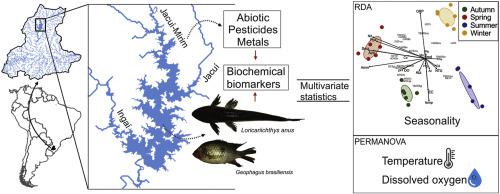Environmental Pollution ( IF 7.6 ) Pub Date : 2020-07-08 , DOI: 10.1016/j.envpol.2020.115168 Aline Monique Blank do Amaral 1 , Letícia Kuhn de Moura 2 , Dionatan de Pellegrin 2 , Luciana Joner Guerra 3 , Felipe Osmari Cerezer 4 , Nathália Saibt 5 , Osmar Damian Prestes 5 , Renato Zanella 5 , Vania Lucia Loro 6 , Barbara Clasen 7

|
Reservoirs are lentic man-made waterbodies resulting from river damming processes. Pollutants coming from adjacent areas can accumulate in the water and sediment of these modified freshwater environments. Fish are often found in reservoirs occupying several trophic niches. Biochemical biomarkers are early warning signals of environmental disturbance to an organism. It is essential to understand how pollutants, abiotic variables and biochemical biomarker responses behave throughout the seasons to implement biomonitoring programs. Loricariichthys anus and Geophagus brasiliensis were collected, and abiotic variables were seasonally measured for one year, at six sampling sites in Passo Real reservoir, in a subtropical region of Southern Brazil. Biochemical biomarkers were analyzed in four tissues of both fish species, as well as metal and pesticide concentrations in the reservoir’s water and sediment. Redundancy analysis (RDA) was carried out to find the temporal relationship between biomarkers and environmental variables. RDA has clearly shown the separation of seasons for both species. Azoxystrobin, simazine and propoxur were the pesticides mostly contributing to the variation, whereas metals had lesser contribution to it. Seasonality appears to be the main factor explaining biomarkers’ variability. PERMANOVA has confirmed the effect of temperature and dissolved oxygen on biomarkers of both fish species. Thus, it is hard to differentiate if the fluctuation in biomarkers’ responses only reflects the normal state of organisms or it is a biological consequence from negative effects of fish exposure to several types of pollution (sewage, pesticides, and fertilizers) entering this aquatic system. In this study, to circumvent the seasonality issue on biomonitoring, the analysis of biomarkers on these fish should not be carried out in organs directly affected by temperature (such as liver and gills), or during reproduction periods (mainly in Spring).
中文翻译:

在巴西南部亚热带水库中,两种鱼类中驱动生化生物标志物的季节性因素:一种综合方法。
水库是由堰塞河形成的透镜状人造水体。来自邻近区域的污染物会积聚在这些改良的淡水环境的水和沉积物中。在水库中经常发现鱼类,这些水库占据了几个营养小生境。生化生物标志物是对生物体造成环境干扰的预警信号。必须了解污染物,非生物变量和生化生物标志物在整个季节中的行为,以实施生物监测计划。肛门猴和巴西乳杆菌在巴西南部亚热带地区的Passo Real水库的六个采样点,收集了一年的非生物变量并进行了一年的季节性测量。分析了两种鱼类的四个组织中的生化生物标志物,以及水库水和沉积物中的金属和农药浓度。进行了冗余分析(RDA),以发现生物标志物与环境变量之间的时间关系。RDA清楚地表明了两种物种的季节分离。嘧菌酯,辛嗪和丙草胺是造成这种变化的主要农药,而金属对这种变化的贡献较小。季节性似乎是解释生物标志物变异性的主要因素。PERMANOVA已确认温度和溶解氧对两种鱼类的生物标志物的影响。从而,很难区分是生物标志物反应的波动仅反映了生物体的正常状态,还是由于鱼类暴露于进入该水生系统的几种类型的污染(污水,农药和化肥)的负面影响而造成的生物学后果。在这项研究中,为了避免生物监测的季节性问题,不应在受温度直接影响的器官(例如肝脏和g)中或繁殖期间(主要在春季)对这些鱼的生物标志物进行分析。











































 京公网安备 11010802027423号
京公网安备 11010802027423号